Have you ever wanted to move beyond marketing theory and into what it takes to successfully market a small business online? Our Digital Marketing Strategies and Tactics course will help your business develop new leads and customers in order for your business or organization to grow.
This article is to designed to help you navigate the course. Digital Marketing Strategies and Tactics to Grow Any Small Business is divided into 10 modules per term, for a total of 3 terms. This follows the conventional quarter system course schedule. If you plan to commit yourself to the entire course, we recommend going at a speed of 1 module per week or perhaps 1 module every 2 weeks if you intend to follow the course purely online.
The course is designed to give you the basics of marketing any business online; once you’ve completed the course you’ll have 80-90% of the knowledge you need as a small business owner to successfully attract enough customers so that you’ll never have to worry about whether you’ll have enough business again.
We currently do not have plans to offer the course in person in La Grande, Oregon, as we have in the past. However, should you need additional training or want hands on help marketing your business you can always reach out using contact form and we would be happy to train you in person.
Modules, 1st Term
- Why Google My Business is Crucial for Small Business Success
- The Top Online Marketing Myths and How They Hinder Small Business Growth
- The 7 Components of a Successful Online Marketing Plan
- How to Write Persuasively to Clearly Demonstrate the Benefits of Your Product or Service.
- How to Employ Search Engine Optimization to Get Free Exposure and Traffic to Your Website
- Whether Pay-Per-Click Advertising is Really Worth It
- What is WordPress and Why is it the Best Platform for Small Businesses?
- The Best Website and Online Marketing Tools to Help Small Businesses Succeed
- The Unrecognized Value Behind Email Marketing
- The Truth About Social Media Marketing
- Affiliate Marketing and How to Start Creating a Supplemental Income Immediately
The course then repeats the same subjects for the following terms. Think of each term as proceeding from beginner, to intermediate, to advanced for each subject.
Module Subjects, 2nd and 3rd Terms
- Google My Business
- Marketing Strategy and Planning
- Copywriting
- SEO
- Pay-Per-Click
- WordPress
- Online Tools
- Email Marketing
- Social Media
- Affiliate Marketing
Why Small Businesses Need Online Marketing
Several reasons exist for why small businesses need to invest time, effort, and even dollars into online marketing efforts. Some of these are obvious, such as the increase in computer and smartphone usage to research businesses and ultimately make buying decisions. But some of the strengths of digital marketing may be less obvious to the unaccustomed. Let’s dive into the top 7 reasons small businesses should get busy with their online marketing. Five of these reasons are conceptual in nature, while the other two refer to trends in consumer behavior. The first five will always be true, while the trends we have noticed (as of 2017) may change over time.
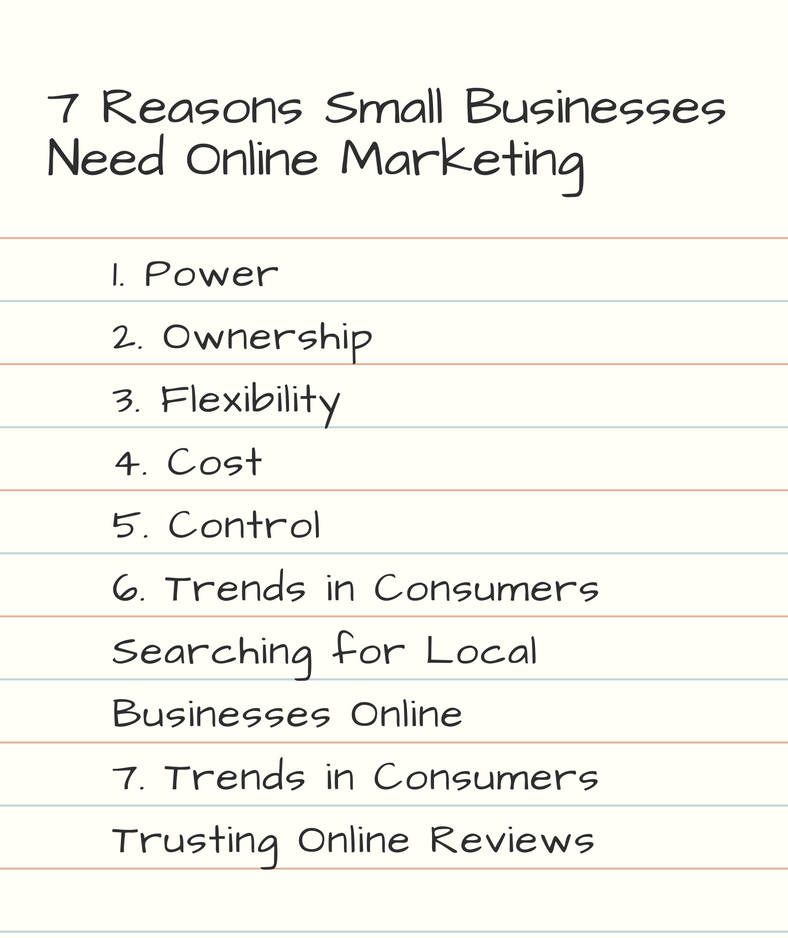
Five concepts drive the need for Online Marketing: Power, Ownership, Flexibility, Cost, and Control.
It will be noted here that these concepts are applicable only to the method of marketing espoused in this course. There are any number of online marketing strategies which can be employed which do not fit where the above concepts do not fit (online gambling marketing, marketing with a heavy emphasis on paid advertising, black hat SEO, etc.). We can define the method espoused in this course as: content marketing based primarily on one’s self-hosted website, where traffic is driven primarily by Search-Engine-Optimization, organic social media and influencer marketing.
#1 – Power
No one can debate the power inherent in presenting information in an an online format. Certainly, creating web content takes a lot of time, but your efforts can be multiplied because of the ability to reach a worldwide audience. Representing your business online is similar to being in two or more places at one time!
Many of you are familiar with the concept of an elevator pitch. Imagine being able to give the elevator pitch for your business to only one person. Now imagine giving the same elevator pitch to a group of ten in the same elevator. Now, imagine giving an elevator pitch to 10 people in 100 separate elevators located in 100 separate countries. Finally, imagine giving an elevator pitch to 10 people in 100 separate countries, yesterday, today, tomorrow, and for the next 100 days, but only having to give that elevator pitch one-time. Such is the power of having content related to your business available online.
Another powerful element in digital marketing (hence the term, digital), is the ability to deliver the message in multiple formats. Text, audio, images, infographics, video – all of these are preferable to different audience members at different points in time.
Personally, if I’m really intent on learning something quickly, I will gravitate towards text-based content such as blog posts, articles, online tutorials, etc. I can easily find the information I want by scrolling the content and looking at sub-headings. Many times, I will read the article in its entirety, if I have time. It’s also easier for me to return to the same article in order to re-read, cut-and-paste, or reference a certain section. This is currently much more difficult to accomplish with audio or video.
If I’m driving, audio, specifically podcasts, are my preferred method of consuming content. I can turn my car into a rolling University, maximizing my time in the car so I can focus on producing content when I am stationary and at my desk.
However, if I want to be entertained, perhaps while eating a meal, I will gravitate towards video. I have to interact far less with content. Video is slightly more passive, it seems, in that I can let the information come to me. As an added bonus, I rarely have to touch the trackpad of my laptop with dirty fingers!
#2 – Ownership
Unlike traditional advertising, the methods promoted in this course are not based on a pay-for-placement system. This is where “marketing” is much broader in scope than simply “advertising,”
If you think about paid advertising, it can usually be accomplished because the other guy – the one charging you – is delivering content in order to drive eyeballs to whatever medium he controls.
Newspapers could be considered one of the oldest forms of content marketing. Because people are willing to look at and read the newspaper, this opens up the opportunity for the newspaper company to be able to charge for space within the newspaper. You pay for access to their audience. Similarly, companies that operate billboards have some sort of control over the land where the billboard is located. This allows them to charge for space on a sign in an area that is highly trafficked.
Finally, we have pay-per-click advertising. Paid advertising only exists because people want access to the organic or unpaid results found in search engines. Indeed, according to Rand Fishkin of Moz, about 90% of the clicks go to the organic (or unpaid) results. While there is profit to be had in pay-per-click, the attractiveness of optimizing one’s site for the organic listings, a practice known as Search-Engine-Optimizaition, is undeniable.
When you own the platform, no one can charge you for the placement of your message. At a minimum, you’ll need to pay for a budget website hosting plan (~$5/month) and possibly a premium WordPress theme (~$50/one-time).
If you create content, there might be costs involved in the creation of the content itself, but no one can charge you to place the content on their medium. It’s only your time and effort involved.
#3 – Flexibility
This segways nicely into the 3rd concept we need to look at when discussing the advantages of online/digital marketing. Once a website or other piece of content exists, there are multiple ways to utilize our platform of choice, which is a website. All of the modules in this course – Copywriting, SEO, Email Marketing, Web Design – all seem to work in harmony to get results for the website owner, whatever the owner’s objective may be.
Personally, I certainly use my website for purposes that have a clear financial outcome. But I also use it for causes which I believe in deeply and which give me no monetary gain.
In addition to multiple types of website utilization, there are multiple ways to promote the message of that website or page.
We’ve already discussed SEO, the practice of making webpages more amenable – simultaneously – to human web users and to the search engines themselves. This is an immensely practical way of driving traffic to a website because of the minimal upkeep needed to continue driving traffic. But there are yet other ways to drive traffic to a website or piece of content. Social Media, E-mail, and even Paid Advertising come to mind. Even print advertising can drive a good deal of direct traffic.
#4 – Cost
The simplest way to think about owning a website and performing content marketing is to think about renting versus owning a home. When you purchase a home, you pay one amount (although you may have a mortgage payment!), and can continue to utilize the benefits of the real estate as you please. With renting, you make recurring payments and are bound to the stipulations provided by the owner of how you may use the property.
This is very similar to owning your online content versus renting. If you advertise on someone else’s platform, let’s say it’s Facebook Advertising, you pay them on a recurring basis and they dictate where you can place the ad. If you create your own content on your own property, you can continue to derive benefits from that piece of content in a residual fashion.
#5 – Control
Within all 4 of these elements is the concept of control. When the message and content is produced on your own property, you have more control over the outcome traffic and conversion of the traffic. When you build your “house” on someone else’s foundation, whether that be Facebook, LinkedIn, Google, etc., they make the rules and can change the rules at anytime, leaving you as the business owner and content creator in the position of having to pivot. One can’t help but think of the mass demonetization of Youtube channels recently that were deemed too politically controversial by Youtube. When you own the web-property, you still have to pivot with changes in technology, the economy, and in your own industry, but these changes can be made according to your own schedule.
Of course, you don’t need to memorize or even know these concepts in order to start taking advantage of content marketing. I certainly didn’t when I started out. But knowing the advantages of digital marketing can certainly influence a business’s willingness to stick with their online marketing efforts.
Now let’s look at emerging trends in consumer behavior that make digital marketing even more attractive.
#6 – 97% of Consumers Search for Local Businesses Online
Currently, consumers are searching for information about local businesses at a rate that outpaces the amount of information given by the businesses themselves. This creates a massive opportunity for small and/or local businesses that decide to get savvy with their marketing efforts.
According to Eventility, 97% of consumers will search for local businesses online. Source: Forbes
In addition, according to research conducted in 2016, “50% of consumers who conducted a local search on their smartphone visited a business [for that search] within a day.” ( Source: Google )
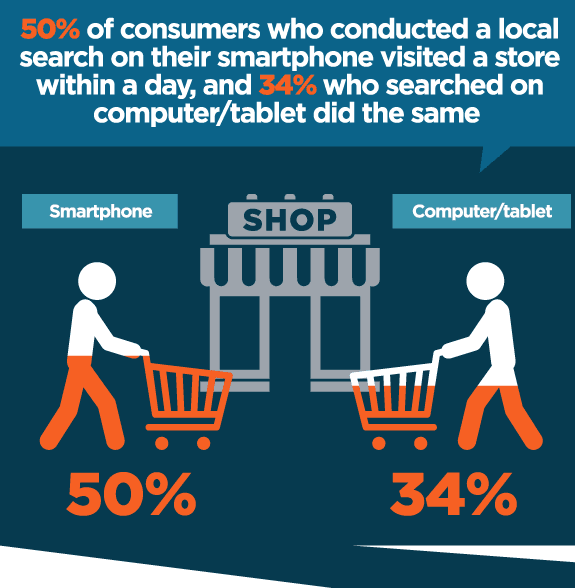
Image Source: Go Globe
#7 – Consumers Trust Online Reviews
The value of online reviews and the effect it can have on small businesses is staggering. Yet, it is perplexing that local businesses place so little value on online reviews.
According to a 2016 survey conducted by Bright Local, the seminal surveyor on the topic, 50% of consumers regularly check online reviews for local businesses, 41% occasionally check online reviews, and only 9% do not check online reviews. So, in total, 91% of those surveyed check online reviews at least some of the time.
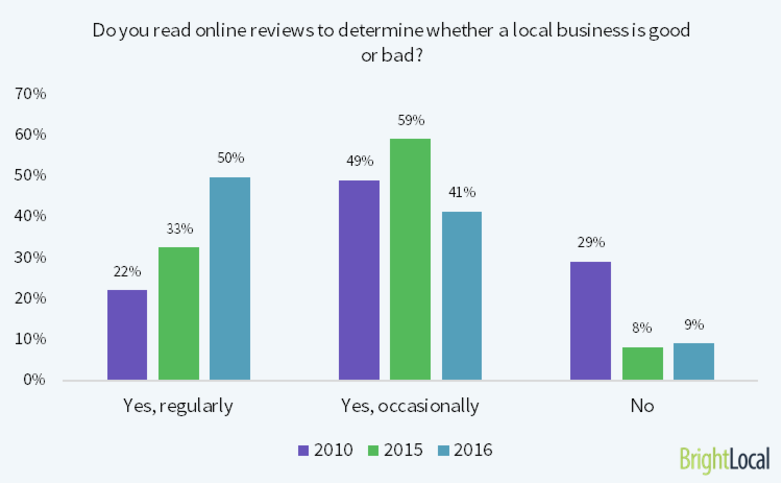
In addition, 39% of people claim that positive reviews make them more likely to use a business, while 24% claim that negative reviews deter them from using a business.
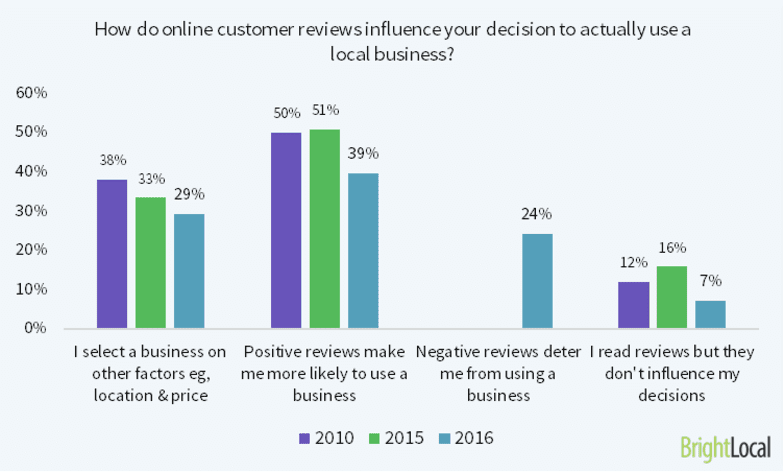
Among the most popular types of businesses that consumers sought reviews for include: (1) restaurants (60% of participants searched for), (2) Hotel/B & B (40%), and (3) Medical/Healthcare (31%).
Finally, 84% of people will trust an online review just as much as they trust a personal recommendation. (source: Bright Local)
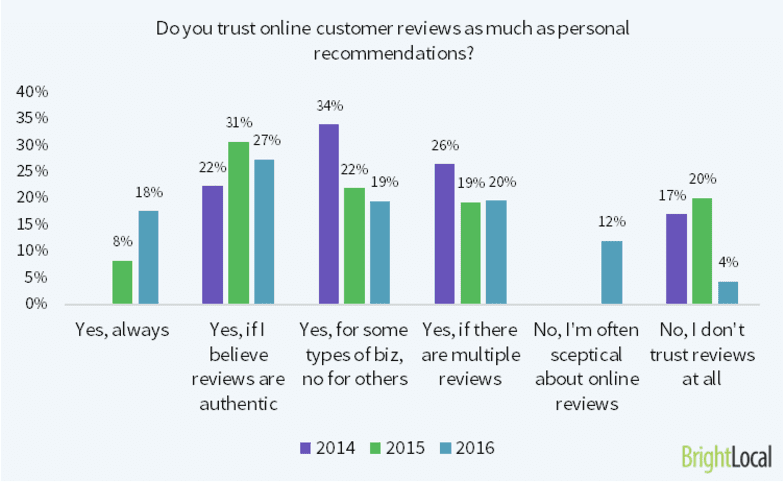
Conclusions Based on Consumer Behavior
These numbers have only increased in favor of consumers reading and trusting online reviews over the years the survey was conducted.
In our course, we’re going to teach you the best methods for reaching out to customers in order to garner positive reviews. According to Reevo, having online reviews results in an 18% uplift in sales. Adding reviews to your “digital portfolio” could be one of the easiest methods to increase sales!
We’ll also share some strategies for reputation management, i.e. what to do when you get a bad review.
Tying this all together is that for 54% of respondents in the Bright Local survey, the next step taken by consumers who read a positive review is to visit the business’s website. While creating a website cannot be considered easy by most of us, this seems to be the next logical step for businesses who do not yet have one.
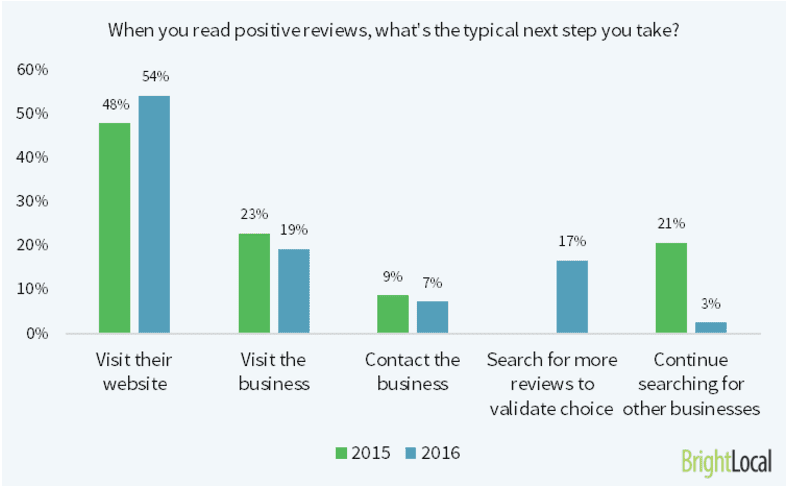
In our course we’ll share with you the best tools on how to create a website, as well as give you some of the basics to get started in designing your own site.
The Need for a Small Business Online Marketing Course
While a vast amount of good information exists regarding the topics we’re going to cover in our course, few resources/websites have broken down the steps necessary to market a business from the perspective of a small business owner. Even fewer have created their content in a systematic fashion in order to take small businesses from point A to point B as quickly and efficiently as possible We have sifted through all the information that isn’t applicable or practical for small businesses.
Finally, we help you make the changes to your online presence in a hands-on fashion, considering your business’s unique circumstances.
If you can’t enlist our help in-person should you happen to live in Eastern Oregon, you can follow along with the articles, video, and audio presented on this site.
We’ll pick it up next time to discuss Why Google My Business is Crucial for Small Business Success.
In the meantime, please answer the question: What’s been your biggest challenge in marketing your small business online? Leave a comment below and we will address your challenge in the course!
What to do Next?
If you are participating in this course formally, whether in-person or online, you’ll need to take the following steps before the next class:
- Sign-up for an account over at the Hubspot Academy. Then, you’ll want to enroll in the Hubspot Inbound Marketing Course.
- Watch the Introduction as well as the first series of videos: Essentials of an Effective Inbound Strategy.
- Take the quiz under “Inbound Fundamentals.” Review the videos and re-take the quiz until you score 100%.
Additional (Optional) Reading:
Forbes: Is Online Marketing Really Necessary for Small Businesses?
The Balance: Top Digital Marketing Strategies for the Small Business

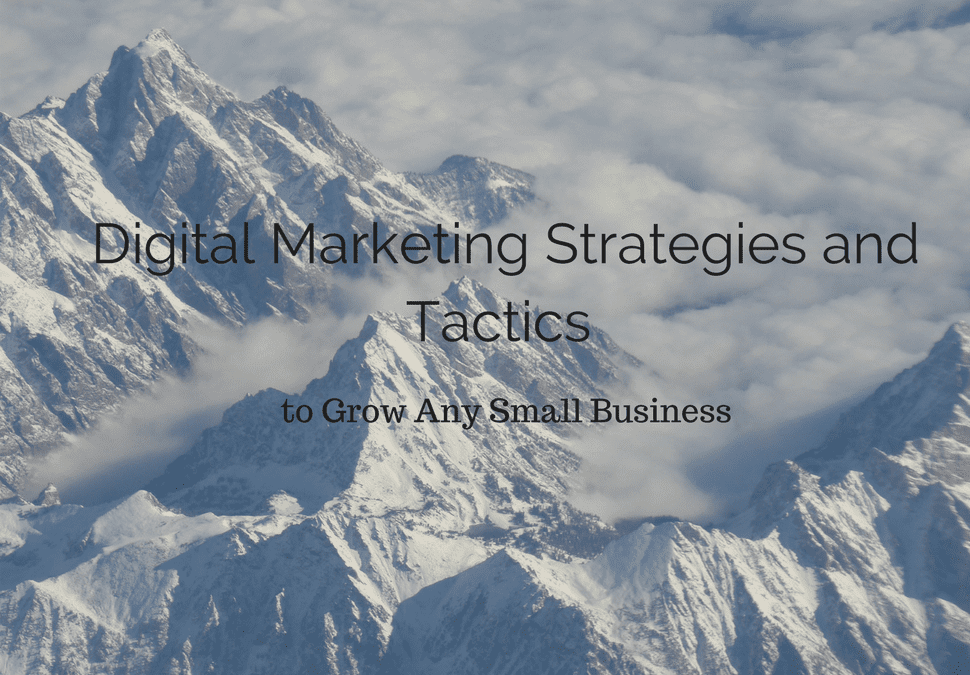
Trackbacks/Pingbacks